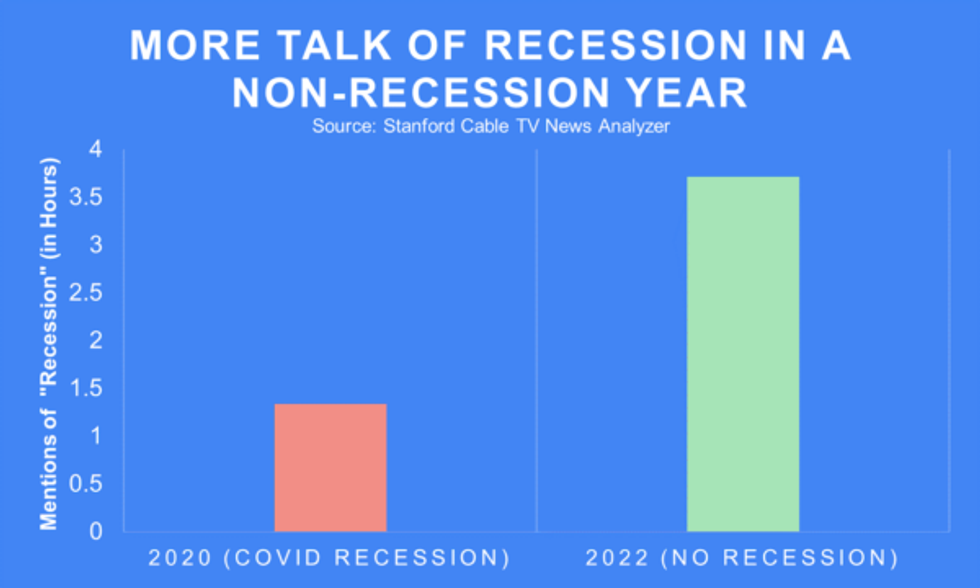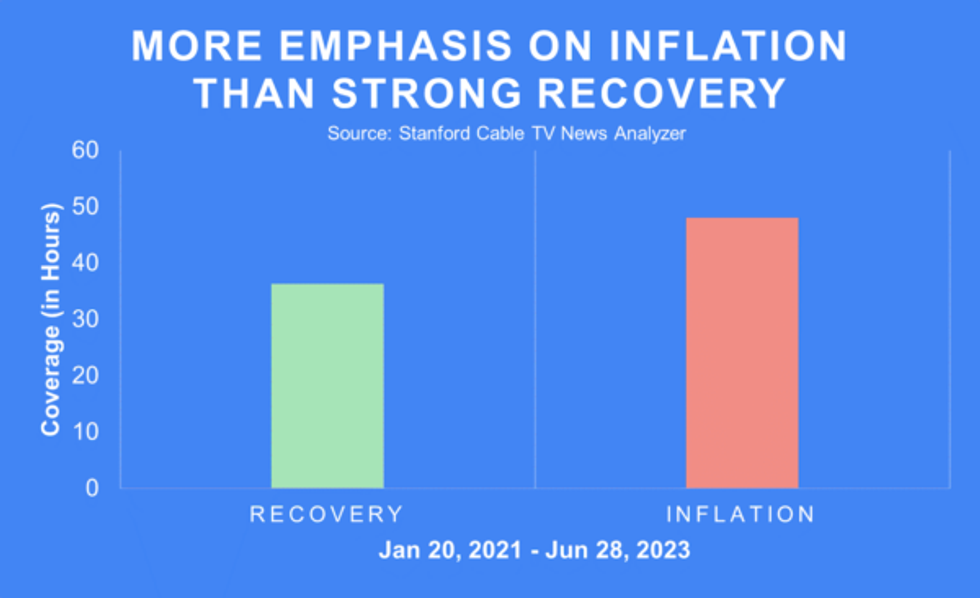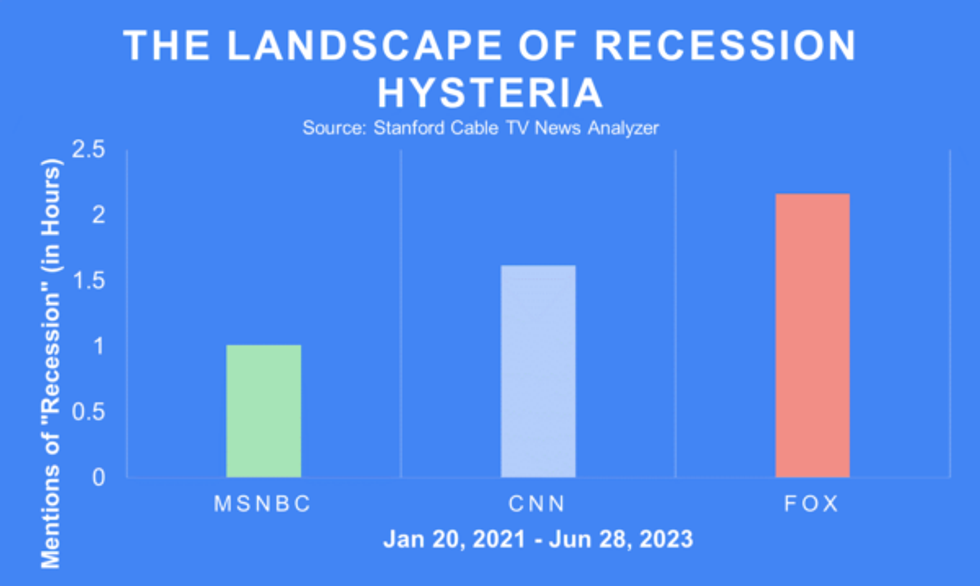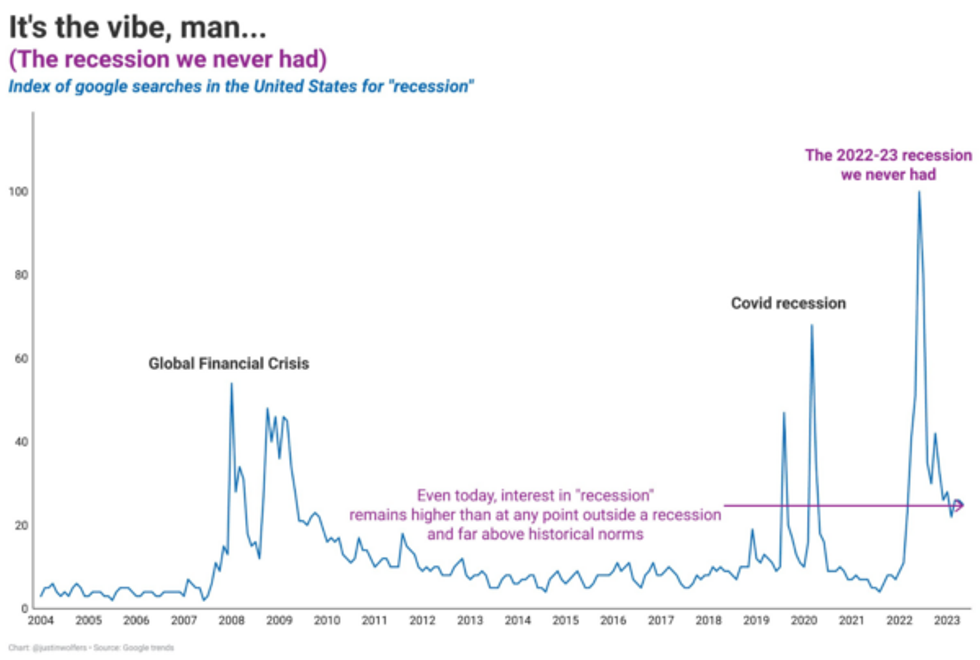By a wide range of metrics, the U.S. is in the midst of a historic economic rebound. In January of this year, the unemployment rate hit a 53-year low of 3.4%. Two months later, prime-age (25–54) employment surpassed its pre-recession peak, putting to shame the sluggish job growth that followed the Great Recession of 2007–09, when it took a full 12 years for prime-age employment to return to its pre-recession level.
Low-wage workers, meanwhile, have seen major gains, far outpacing their real (inflation-adjusted) wage growth during previous business cycles.
The blight on this recovery has been a surge in inflation, though that hit its high point in the summer of 2022, and inflation has been falling ever since. As international data highlight, this problem has been globally shared, not U.S.-specific.
And even here, the U.S. has not fared too poorly. Despite having at first higher inflation than other rich countries, the U.S. now has the lowest inflation of any G7 country. All the while, its recovery, as measured by real GDP, has been the strongest.
While the United States remains a deeply unequal country with relatively high levels of poverty, looking at key indicators valued by the media points to a remarkably strong recovery in the face of significant headwinds. As the progressive economist Dean Baker (Beat the Press, 5/10/23) recently put it:
Everyone knows damn well that if Donald Trump was in the White House and we had the same economic situation, he would be boasting about the greatest economy ever all the time. Every Republican politician in the country would be touting the greatest economy ever. And all the political reporters would be writing stories about how the strong economy will make it difficult for the Democrats to beat Trump in the next election.
What Recovery?
If you were a casual consumer of the news over the last couple years, you may not have heard much about these success stories. You may, in fact, think that everything has suddenly gone wrong all at once.
And it would be hard to blame you. In the wake of a historically progressive response to an economic downturn, corporate media have been intently focused on the negative.
News articles, for instance, have focused overwhelmingly on inflation. Mark Copelovitch, a political scientist at the University of Wisconsin-Madison, has been tracking this trend for the last couple years. His most recent update, which he posted in early June, shows that, since the start of 2022, the word “inflation” has appeared in the headline or subheading of more than 17 times as many articles as the words “unemployment” and “jobs” (both of which are metrics associated with the strong recovery) combined.
Strikingly, recession was discussed far more in 2022 than in 2020—almost three times as much. The difference? In 2020, there actually was a recession. In 2022, there was none.
Also notable: Over the same time period, the word “recession” has shown up in the headline or subheading of 10 times as many articles as has the word “recovery.” Strange, considering there was no recession in 2022, and there has been no recession this year so far. Instead, the recovery has chugged along nicely.
On television, the story has been much the same. According to data from the Stanford Cable TV News Analyzer, since the start of Joe Biden’s presidency, “inflation” (which has been unusually high during this period) has garnered more than six times as much attention as “unemployment” (which has been unusually low) across Fox News, CNN, and MSNBC.
Over the same period, “recession” and “recovery” have been mentioned roughly the same amount on these channels, a more balanced outcome than in the case of news articles, but still promoting a misleadingly dreary picture of the economy. Strikingly, recession was discussed far more in 2022 than in 2020—almost three times as much. The difference? In 2020, there actually was a recession. In 2022, there was none.

If we look more broadly at the television coverage of positive aspects of the economy versus negative ones, we see that the negative has taken priority. Back in 2021, the liberal think tank Center for American Progress found that, over a one-month period,
the terms “inflation” and “prices” garnered 50% more screen time on CNN and MSNBC than mentions of these terms: “unemployment,” “employment,” “wages,” “jobs,” “jobless,” “consumer spending,” “GDP,” “income,” “stock market,” “wage growth,” “job growth,” and “economic growth” combined.
Using this same framework, if we look at the Biden presidency so far, we see that “inflation” and “prices,” which point to troubles, have continued to draw more attention than the rest of the terms, which point to the strong recovery. Across Fox News, CNN, and MSNBC, “inflation” and “prices” have gotten 32% more screen time than the other terms combined over this period.

Economic Disinformation
Unsurprisingly, this negative coverage has been driven primarily by right-wing media. Of the three outlets considered, Fox had by far the most disproportionate focus on inflation. MSNBC was the only one with more coverage of the positive parts of the recovery than inflation. It’s worth noting, though, that CNN and MSNBC together still had more coverage of inflation than the recovery over the full period, so this negativity isn’t solely a right-wing phenomenon.
Nevertheless, if we hone in on specific terms, right-wing media continue to lead the pack in economy-bashing. For instance, on Fox, “inflation” has gotten nine times as many mentions as “unemployment” during Biden’s presidency. On CNN, the ratio is more like six-to-one. And on MSNBC, it’s four-to-one. During this period, Fox’s inflation panic has reached the level of absurdity, with the outlet in one case emblazoning “Empty Shelves Joe” over an old photo taken in a Japanese supermarket after the 2011 Fukushima nuclear disaster.

Foxhas been a leader in recession hype as well. Its coverage has included such headlines as:
- “Fox & Friends Hosts on Biden Admin Denying U.S. Is in Recession” (7/29/22)
- “White House Denying Recession Is a ‘Reach’: Kudlow” (7/29/22)
- “Biden Adviser Deflects From Economic Recession” (7/28/22)
- “US Economy Reports Second Quarter of Negative GDP, Signals Official Recession” (7/28/22)
These headlines are economic disinformation. The National Bureau of Economic Research (NBER), which determines when recessions have officially occurred, defines a recession as “a significant decline in economic activity that is spread across the economy and lasts more than a few months.” Notice that this is not the definition Fox offered: two quarters of negative GDP growth.
The NBER did not end up declaring a recession in 2022, despite real (inflation-adjusted) GDP shrinking at a 1.6% rate in the first quarter and 0.6% in the second, because other economic indicators at the same time were pointing to continued expansion: Consumer spending was strong and employment was booming. GDP growth for the entire year ended up being a 21st century-normal 2.1%. But, you know, Fox is never one to let the facts get in the way of their feelings.
Quacking Like a Recession
The hysteria has not all been Fox-driven, of course. CNN has often been more than happy to join the doom-and-gloom brigade. In July of 2022, for instance, it ran a piece (7/26/22) headlined “If It Looks Like a Recession and Quacks Like a Recession…” that opened:
Is the United States heading for a recession? Or is the economy already in one? It—almost—doesn’t matter.
For many Americans, it already feels like a recession.
Recession, no recession? I don’t know. But the vibes, they’re way off, man.
CNN’s television content from around the same time was no better. News banners from the last week of July included:
- “Biden Dismisses Recession Fears as Inflation Plagues Americans” (7/28/22)
- “Consumer Confidence Slumps Amid Inflation Sting, Recession Fears” (7/26/22)
- “Biden Downplays Recession Fears Ahead of Key Economic Report” (7/25/22)
The last of these flew under a graphic showing 64% of Americans believed that the U.S. economy was in a recession. It wasn’t—but where could they have gotten the idea that it was?
One segment from the same week (7/25/22) featured an image of dollar bills with a red line trending downwards, and the words “Critical Week” underneath. In the segment, an anchor warned that
two negative quarters in a row [of GDP growth] could be viewed as a sign of a recession. And on Friday, new numbers on the country’s historically high inflation will be released.
Armageddon!
On inflation, CNN somewhat infamously ran a segment on rising milk prices that included the line: “A gallon of milk was $1.99. Now it’s $2.79. When you buy 12 gallons a week times four weeks, that’s a lot of money.”
As Dean Baker (Beat the Press, 11/24/21) commented at the time, leaving aside the absurdity of focusing on a family of milk-hoarders rather than a typical family:
Where did [CNN] find milk prices going up by 80 cents a gallon, or slightly over 40%? The Consumer Price Index shows that milk prices are up 4.0% year over year. There are differences for types of milk and by region, but it’s hard to imagine that there is anywhere in the country where milk prices have risen by 40% over the last year.
Contextualizing Inflation
MSNBC has been the outlier among these major outlets, with a much more balanced approach to discussing the economy. The outlet has run segments contextualizing the inflation situation and criticizing the over-reaction of some to more quickly rising prices.
For instance, in late 2021, Chris Hayes (11/11/21) brought on progressive journalist Ryan Cooper to discuss “the American obsession with the price of gas,” as the banner put it. Another host, Ali Velshi (10/22/22), has emphasized that inflation is a global problem, not one caused primarily by U.S. policies. And anchor Joy Reid (Mediaite, 11/3/22) has sharply criticized Republican fearmongering over inflation, sparking widespread backlash from right-wing media (Fox, 12/4/22, 12/4/22; Daily Mail, 12/4/22; Washington Examiner, 12/4/22).
This is not to say that MSNBC has not engaged in any sort of over-the-top fretting about inflation. Its coverage (11/13/21) of food prices in the run up to Thanksgiving in 2021, for one, put inflation fears front and center:
This year items on your Thanksgiving dinner table are going to be more expensive due to inflation. Experts say that it is at its highest level in over 30 years. But it’s not just food. The cost of your energy bill is on the rise, too. In fact, over the past year, natural gas has increased 130%. Oil, that’s up 59%. And a gallon of gas, that’s risen nearly 54%.
But even in this case, the host then brought on Rep. Ro Khanna to discuss progressive responses to inflation, including investing in a green transition to protect people from the volatility of gas prices, and increasing government support for the working class.
The doom-and-gloom approach to economic news, then, has had exceptions. But the overall skew, across news articles and television coverage, has clearly been negative. Even a more liberal outlet like MSNBC has been highly focused on the negative economic indicators: It has given “inflation” four times as much screen time as “unemployment” during Biden’s presidency; it also featured “recession” 26% more often in the non-recession year of 2022 than in the recession year of 2020. Though MSNBC may give more context about the full picture, woes remain in the foreground.
The Negativity Effect
This negativity bias has clearly had an effect on how people feel about the economy. Researchers at the Federal Reserve Bank of San Francisco have reported a spike in the percentage of people who report hearing news about inflation, and a concomitant spike in the negativity of that news. According to their analysis, this news has in turn played a significant role in heightening fears of higher inflation continuing for longer.
Meanwhile, with all the worrying over a recession in the media, Google searches for the term “recession” skyrocketed in 2022, over and above how much they rose during 2020, when there was an actual recession.

In this environment, any discussion of Biden’s poor approval ratings on economic policy has to include consideration of the media’s role in manufacturing those ratings. In the wake of the Covid recession, in May 2020, Trump’s disapproval on this measure hit 51%. Biden’s most recent rating is a full 16 points worse, at 67% disapproval. This despite a much stronger economy than in May of 2020—the unemployment rate, for one, is nearly 10 percentage points lower now.
If we want to understand how progressive policy is undermined by a media owned by the wealthy, the experience of the last several years offers a case study. In the wake of robust government intervention in 2020 and 2021 that cut inequality and boosted incomes, especially for those at the bottom, inflation-mania has taken over in the media.
Inflation is being covered more than it was previously, which is eminently reasonable. But inflation and recession fears have also completely overshadowed coverage of a historically strong recovery, which is not so reasonable. To the average news consumer, the natural conclusion is likely: This recovery doesn’t seem to be going so well. And the takeaway regarding the massive government stimulus that propelled the recovery? Maybe we shouldn’t do that again.





